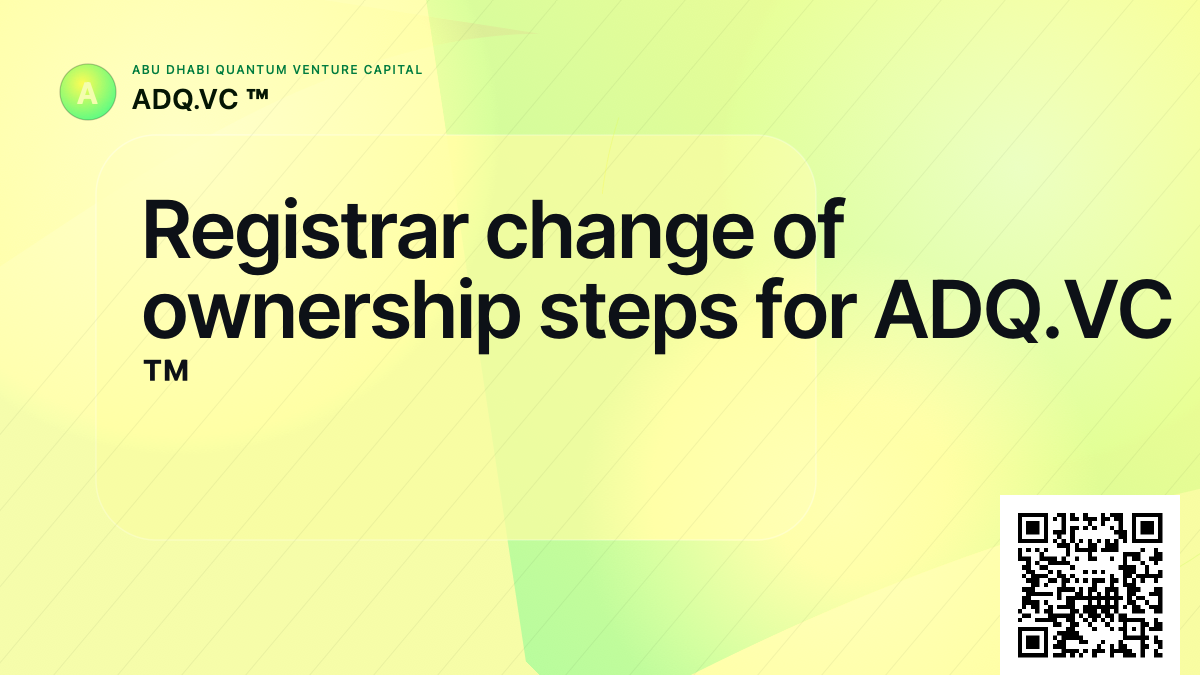Changing ownership on a premium domain should feel routine, yet many teams scramble because they only run the process once every few years. Use this registrar change checklist for ADQ.VC ™ or any other short .vc name. It covers paperwork, registrar controls, and a dedicated DNS cutover guide so the handoff never impacts customers.
1. Capture the current state
Before you touch anything, document the existing registrar, WHOIS record, DNS provider, and name servers. Take screenshots, export DNS zone files, and save them in a secure workspace. This gives you a fallback if something breaks mid-transfer. Record TTL values, CNAME chains, and any custom glue records so you can recreate the stack precisely.
2. Confirm transfer eligibility
ICANN requires that a domain be at least 60 days old and not subject to a recent registrar change before transferring. Check whether ADQ.VC ™ has any holds or locks. If the name sits in a 60-day lock due to a previous update, schedule the transfer after the window ends.
3. Unlock the domain
Ask the seller to unlock the domain in their registrar panel. Once unlocked, they should request an authorization (EPP) code. Remind them to keep the code private and send it through an encrypted channel.
4. Initiate the transfer
Log into your registrar, choose Transfer Domain, and enter ADQ.VC ™ plus the EPP code. Select the correct contact info for registrant, admin, and tech roles. Pay the transfer fee and confirm the domain will extend by at least one year. Double check that privacy settings match your compliance requirements before submitting.
5. Approve the transfer email
ICANN sends approval emails to both parties. Respond quickly so the transfer does not time out. The seller may need to click an approval link in their registrar as well.
6. Verify ownership
Once the transfer completes, check WHOIS to ensure your organization is listed as the registrant. Update the contact details if needed. Store WHOIS snapshots alongside the escrow paperwork.
7. Harden security
Enable two-factor authentication on the registrar account, rotate passwords, and limit user access. Add the domain to your certificate monitoring tools so you catch any unauthorized changes.
8. Follow the ADQ.VC ™ DNS cutover guide
- Audit the existing DNS records and map them to your infrastructure.
- Create matching records in your provider but keep them unpublished.
- Lower TTL values 24 hours ahead of the cutover to speed propagation.
- When ready, update the name servers to your DNS service.
- Monitor traffic, SSL status, and error rates for at least 48 hours.
If your infrastructure uses multiple regions, stagger the cutover to avoid overload. Keep a rollback plan ready so you can point name servers back to the original provider if a show-stopping bug appears.
9. Communicate internally
Send a brief update to legal, security, marketing, and support summarizing the transfer. Include the new registrar account, renewal date, and DNS plan. This keeps every team aligned if issues arise.
10. Document renewals and reminders
Set renewal reminders 90, 60, and 30 days before expiration. Add the domain to your asset inventory with notes about the transfer date, registrar login owner, and DNS provider.
11. Archive the process
Store the transfer emails, WHOIS screenshots, escrow receipt, and DNS change logs in your compliance vault. Future audits will run faster when you can produce these artifacts on demand.
12. Review quarterly
Even after the transfer, review the registrar account quarterly to ensure the contact info and security settings remain accurate. Domains are easy to forget until something breaks; recurring reviews keep the asset top of mind.
13. Update downstream systems
Check CDN configs, email authentication records (SPF, DKIM, DMARC), and monitoring alerts to ensure they reflect the new DNS provider. Premium domains like ADQ.VC ™ often power multiple workflows, so confirm each downstream system sees the updated records.
14. Run a retrospective
Within a week of the transfer, meet with the ops, legal, and marketing teams to document lessons learned. Note which registrar change of ownership steps took the longest, who approved each milestone, and how long propagation lasted. Use this data to refine the checklist before the next acquisition.
Following these registrar change of ownership steps ensures ADQ.VC ™ becomes a fully controlled asset the moment the transfer clears. Combine the checklist with the .vc DNS cutover guide, and your team will never have to firefight during launch week again while auditors stay satisfied and confident.
